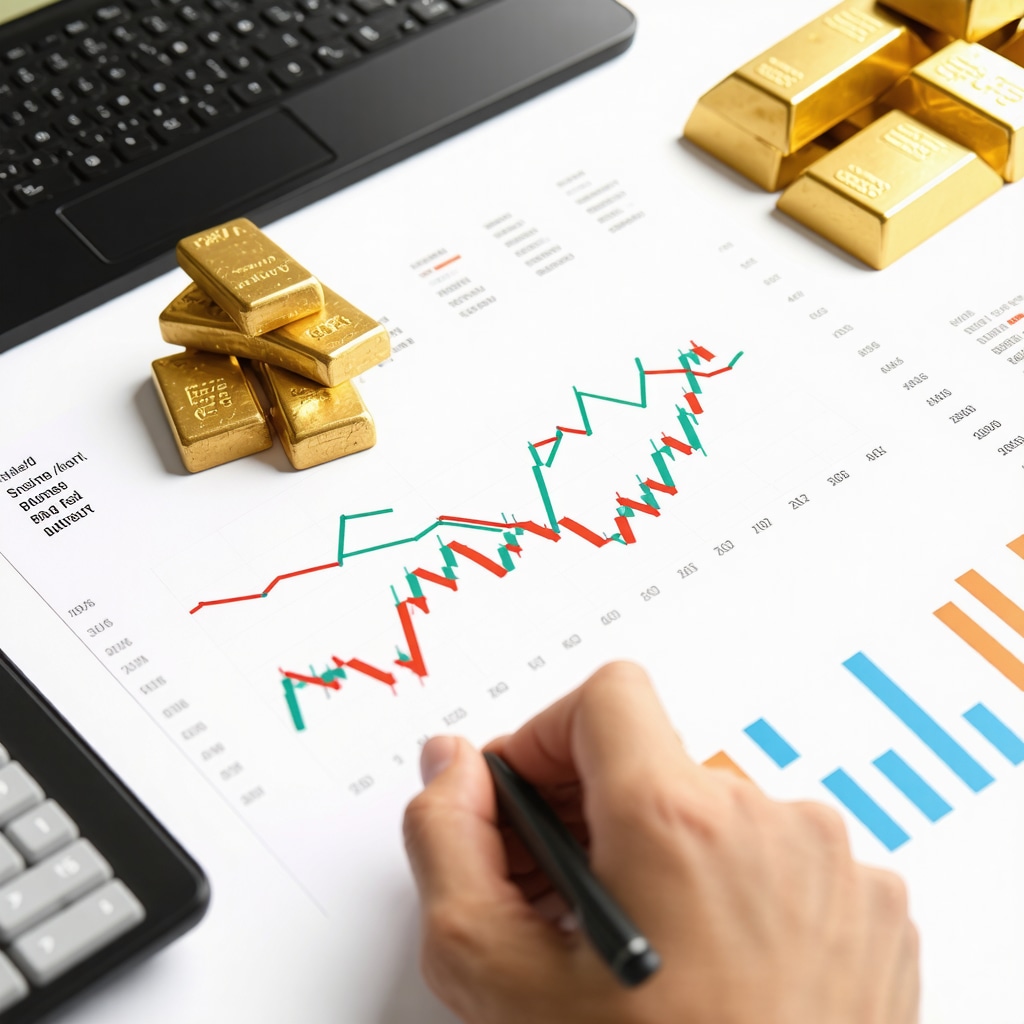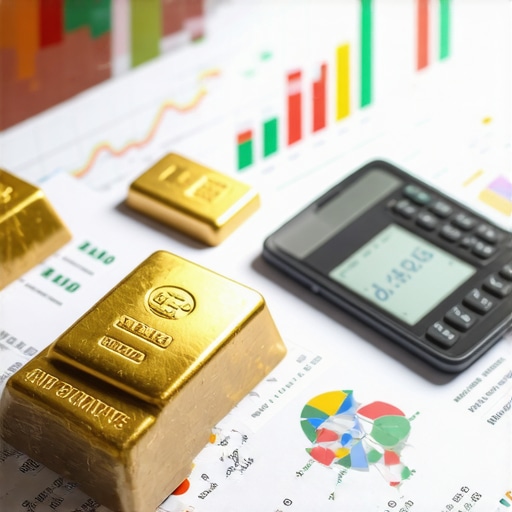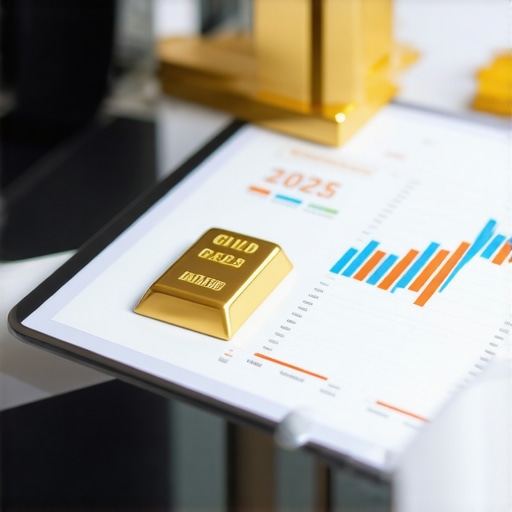How I Started Exploring Gold ETFs Versus Mutual Funds
When I first dipped my toes into investing, I was overwhelmed by the choices—especially when it came to gold investments. I remember sitting at my kitchen table, laptop open, trying to decide between gold ETFs and mutual funds. Both promised exposure to gold, but their structures and potential returns seemed worlds apart. Over time, through trial, error, and research, I gathered enough insight to weigh which might yield better returns for someone like me.
The Tangible Feel of Gold ETFs Versus the Managed Approach of Mutual Funds
Gold ETFs felt like a more direct way to invest in gold. They trade on exchanges like stocks, offering liquidity and transparency that appealed to my preference for control. I appreciated that many gold ETFs are backed by physical gold, which meant my investment mirrored actual market prices closely. On the other hand, gold mutual funds pooled money to invest in a combination of gold-related assets, including mining stocks and futures. This active management promised diversification but also came with higher fees and sometimes unpredictable performance.
What Are the Real Differences in Yield Between Gold ETFs and Mutual Funds?
From my experience and reviewing historical data, gold ETFs often provide returns more tightly correlated with the gold spot price, which can be beneficial in a rising gold market. Mutual funds, with their mix of assets, might outperform during certain cycles, especially if mining stocks rally. However, fees tend to eat into mutual fund yields more noticeably. According to a detailed analysis by Investopedia, gold ETFs generally have lower expense ratios compared to mutual funds, which can translate into better net returns over time.
Personally, I found that gold ETFs suited my hands-on investing style and my desire for cost-effective exposure to gold prices. Mutual funds, while potentially rewarding, felt less transparent and required more trust in fund managers’ decisions.
Lessons I Learned from Mixing Both in My Portfolio
After experimenting, I decided to maintain a blend—using gold ETFs for core exposure and selectively adding mutual funds when I wanted to tap into mining sector growth. This balance helped me hedge risks and capture different market dynamics. It’s worth noting that for investors interested in tax advantages and retirement planning, exploring gold IRAs can be an excellent complement. I found some useful insights on this at Buying Gold Now.
Have you tried investing in gold ETFs or mutual funds? What has your experience been like? Feel free to share your thoughts or questions below—I’d love to hear different perspectives!
Understanding the Impact of Expense Ratios and Management Styles on Long-Term Returns
One crucial nuance I uncovered in my journey comparing gold ETFs with mutual funds is how expense ratios and management styles directly influence long-term portfolio growth. Gold ETFs typically boast lower expense ratios, frequently ranging from 0.25% to 0.50%, primarily because they are passively managed and aim to replicate the price of physical gold. In contrast, gold mutual funds often charge fees between 0.75% and 1.50%, reflecting active management, research, and broader asset diversification.
These differences become magnified over extended investment horizons. Even a seemingly small fee gap can significantly erode compounded returns. Additionally, active management in mutual funds can lead to performance variability; while some managers skillfully capitalize on mining stock rallies or sector shifts, others may struggle during volatile markets. This variability introduces an element of unpredictability that investors should carefully weigh against their risk tolerance and investment goals.
Navigating Volatility: How Gold ETFs and Mutual Funds Respond Differently
Market volatility impacts gold ETFs and mutual funds in distinct ways. Since gold ETFs track the physical price of gold closely, their volatility is primarily tied to gold’s market fluctuations. Investors seeking a clear hedge against inflation or currency devaluation might find this direct correlation advantageous. Conversely, mutual funds, with holdings including gold mining companies and derivatives, often experience amplified volatility due to factors like operational risks, geopolitical events, and commodity price swings affecting mining stocks.
This complexity means mutual funds can offer higher upside potential during bullish mining cycles but also carry added downside risk during downturns. For example, during the 2020 market turbulence, some mining-focused mutual funds outperformed gold ETFs, benefiting from operational leverage and rising gold prices. However, in other periods, mining stocks underperformed the metal itself, underscoring the importance of timing and active management prowess.
Can Combining Gold ETFs and Mutual Funds Enhance Portfolio Resilience?
Given these dynamics, a question arises: does blending gold ETFs and mutual funds provide a more resilient and diversified approach? The answer, in my experience and supported by research, is yes. By allocating core holdings to gold ETFs, investors secure stable exposure to gold prices with low costs and transparent liquidity. Supplementing this with a tactical allocation in mutual funds allows participation in mining sector growth, which can amplify returns during favorable market conditions.
This hybrid strategy demands ongoing monitoring and rebalancing to manage risks effectively. Investors should assess the fund managers’ track records and the underlying asset composition of mutual funds to ensure alignment with their investment objectives.
For those interested in expanding their knowledge on effective gold investment strategies, including how to hedge against inflation and maximize returns, I recommend exploring resources like essential gold investment strategies.
Evaluating Tax Considerations and Retirement Planning with Gold Investments
Another layer of complexity involves tax implications. Gold ETFs held in taxable accounts may generate capital gains taxes upon sale, similar to stocks. Mutual funds might distribute dividends or capital gains annually, potentially creating taxable events regardless of whether you sell. This factor can influence after-tax returns significantly.
For investors focused on retirement planning, utilizing a Gold IRA can offer tax advantages and long-term security. I found detailed guidance on this topic very helpful at Gold IRA benefits explained. Incorporating gold into retirement accounts can shield gains from immediate taxation and diversify retirement portfolios against economic uncertainties.
How have tax considerations influenced your approach to investing in gold ETFs or mutual funds? Sharing your experiences or questions can enrich our collective understanding.
When Market Cycles Challenge Your Gold Investment Choices
One aspect that truly reshaped my perspective was witnessing firsthand how different market cycles impacted my gold ETFs and mutual funds. During bullish phases for gold mining stocks, my mutual funds often outpaced ETFs due to their leveraged exposure to operational profits and sector momentum. However, in bear markets, those same funds took heavier hits, sometimes significantly underperforming ETFs that tracked the metal price more closely.
This volatility taught me that timing and market awareness are crucial if you want to leverage the potential gains from gold mutual funds. For investors less inclined to monitor market swings constantly, gold ETFs offer a steadier and more predictable ride. I found it useful to check credible market analyses like those on Gold Price Forecast 2029 to anticipate shifts that might favor one investment type over the other.
How Do You Balance Patience and Opportunism in Gold Investing?
This question has intrigued me throughout my journey. Balancing patience—holding steady through market ups and downs—with opportunism—capitalizing on favorable conditions in mining stocks or physical gold prices—requires both discipline and informed flexibility. My approach has evolved into a hybrid one: maintaining a core position in gold ETFs for stability, while selectively increasing mutual fund exposure when indicators suggest mining stocks could surge.
It’s a nuanced dance that demands continuous learning and sometimes accepting short-term discomfort for long-term gains. If you’re interested in exploring tactical allocation strategies further, the insights shared in Effective Gold Investment Strategies provide a thoughtful framework.
Personal Reflections on the Emotional Side of Gold Investing
Investing in gold isn’t purely a numbers game—it’s deeply emotional, too. I’ve experienced moments where watching mining mutual funds plunge on geopolitical tensions or market crashes tested my conviction. Conversely, the calm steadiness of gold ETFs sometimes provided a reassuring anchor amidst turbulence.
These emotional responses influenced how I adjusted my portfolio and risk tolerance. I realized that understanding your own psychological comfort with volatility and complexity is as important as the technical aspects of ETFs versus mutual funds. It’s why I often encourage fellow investors to reflect on their personal investment temperament alongside financial goals.
If you’ve noticed how emotional factors shape your investment decisions, I’d love to hear your stories or strategies. Sharing these experiences enriches our collective wisdom and helps build more resilient investment communities.
Exploring Further: How Does Global Demand Shape Your Gold Investment Outlook?
Another layer I found fascinating is the impact of global gold demand trends on the performance of ETFs and mutual funds. Physical demand—driven by jewelry, technology, and central bank purchases—directly supports gold prices, benefiting ETFs that mirror the metal’s spot price. Meanwhile, mining mutual funds react more to operational efficiencies and geopolitical risks affecting supply.
Keeping an eye on comprehensive market reports, like those highlighted in Understanding Gold Demand Trends, helped me anticipate price movements and adjust my allocations accordingly. This macro perspective adds valuable context beyond just charts and fund performance.
Decoding the Influence of Geopolitical Shifts on Gold Investment Dynamics
Reflecting on my journey, one intricate layer I encountered involves how geopolitical events distinctly sway gold ETFs compared to mutual funds. Gold ETFs, tethered closely to the physical metal’s price, often serve as a sanctuary during global uncertainty, providing a relatively predictable hedge. In contrast, mutual funds that include mining stocks are affected not only by gold prices but also by operational risks associated with geopolitical tensions, such as regulatory changes, mine nationalizations, or trade restrictions.
This dual exposure means that while ETFs might maintain steadier footing, mutual funds can experience amplified swings—both upside and downside—making them more sensitive barometers of geopolitical stress. For instance, when a mining country faces political instability, mining stocks could plummet even as gold prices surge. This complexity demands a nuanced understanding and proactive portfolio adjustments.
Leveraging Quantitative Analytics to Optimize Gold Investment Allocations
Taking my analysis further, I delved into quantitative methods to assess the risk-return profiles of gold ETFs and mutual funds within a diversified portfolio. Utilizing metrics like Sharpe ratios, beta coefficients, and drawdown analysis, I found that gold ETFs consistently offered lower volatility and steadier correlation with inflation hedging, while mutual funds exhibited higher beta, reflecting their leveraged sensitivity to market cycles and sector-specific risks.
Incorporating these analytics helped me tailor allocation percentages dynamically — favoring ETFs during uncertain or bear markets and increasing mutual fund exposure tactically during bullish sectors. This data-driven strategy is detailed in resources like top gold ETFs for balanced portfolio growth, which I found instrumental for applying sophisticated portfolio management techniques.
How Can Advanced Investors Navigate Liquidity Constraints and Premiums in Gold ETFs Versus Mutual Funds?
Advanced investors often grapple with the subtle issues of liquidity and premium/discount spreads inherent to gold ETFs and mutual funds. While ETFs generally offer intraday liquidity, market conditions occasionally cause their trading price to diverge from net asset value (NAV), resulting in premiums or discounts that impact returns. Mutual funds, priced once daily, avoid intraday volatility but may suffer from liquidity constraints during market stress, especially if underlying mining stocks become illiquid.
Understanding these nuances is critical for timing entry and exit points. Personally, I monitor bid-ask spreads and premium data closely and recommend investors explore analytical tools and commentary on liquidity dynamics as part of their strategy. The authoritative insights provided by SEC’s investor bulletin on gold ETFs offer valuable guidance on these operational intricacies.
Integrating Sustainable and ESG Factors into Gold Investment Decisions
Recently, I began factoring Environmental, Social, and Governance (ESG) criteria into my gold investment considerations, especially regarding mutual funds that invest in mining stocks. Mining operations have pronounced environmental footprints and social implications, so scrutinizing fund managers’ ESG policies became essential for aligning my portfolio with ethical standards and long-term sustainability trends.
Gold ETFs typically track physical gold and thus have limited ESG exposure, while mutual funds can vary widely based on their holdings. This dimension introduced a fresh layer of complexity but also opportunity, as funds with strong ESG commitments might outperform over time by avoiding regulatory pitfalls and reputational risks.
For a deeper dive into ESG integration in gold investments, I recommend visiting this comprehensive analysis that explores how sustainability factors reshape gold investment strategies.
I’d love to hear how you’ve integrated ESG considerations into your gold investing or your thoughts on balancing ethical concerns with financial objectives—please share your experiences or questions below to enrich our collective understanding.
Things I Wish I Knew Earlier (or You Might Find Surprising)
Sometimes, Simplicity Outperforms Complexity
Early on, I thought that more complex strategies—like heavily managed mutual funds—would naturally yield better returns. But I discovered that simplicity, especially with gold ETFs that track physical gold prices, often translates to more predictable outcomes and lower costs. This was a refreshing lesson in embracing straightforward investment vehicles.
Volatility Isn’t Just Numbers—it’s Emotional
Watching my mining mutual funds swing wildly during geopolitical events taught me that volatility is much more than a statistic. It’s deeply personal and can challenge your conviction. Recognizing my own emotional thresholds helped me tailor my portfolio to balance growth with peace of mind.
Expense Ratios Compound Over Time More Than Expected
I underestimated how even small differences in fees could erode gains over years. The lower expense ratios of ETFs became a big selling point, especially as I aimed for long-term growth without constantly siphoning returns to management fees.
Global Demand Trends Are More Than Headlines
Keeping tabs on physical gold demand from jewelry, technology, and central banks gave me a macro lens that helped explain price movements beyond charts. It made my decisions feel more informed and connected to real-world factors.
ESG Matters—and It’s Evolving Fast
Integrating Environmental, Social, and Governance considerations reshaped how I view mutual funds investing in mining stocks. It’s not just about returns anymore; it’s about investing responsibly. This adds nuance but also aligns investments with values, which I find increasingly important.
Resources I’ve Come to Trust Over Time
Investopedia’s Gold ETFs vs Gold Miners Article: This resource helped me grasp the fundamental differences and performance implications between ETFs and mutual funds, grounding my early research in solid facts.
Buying Gold Now’s Gold IRA Benefits Explained: When I explored tax advantages and retirement planning with gold, this guide was invaluable for understanding how to incorporate gold effectively into IRAs.
Buying Gold Now’s Essential Gold Investment Strategies: This collection of strategies deepened my appreciation for hedging inflation and timing market cycles, which shaped my hybrid portfolio approach.
SEC’s Investor Bulletin on Gold ETFs: For understanding liquidity nuances and premium/discount spreads, this official guidance helped demystify operational risks and timing considerations.
Buying Gold Now’s ESG Analysis in Gold Investments: This analysis opened my eyes to how sustainability factors influence mining fund selections and long-term portfolio resilience.
Parting Thoughts from My Perspective
Reflecting on my journey comparing gold ETFs and mutual funds, I realize that there isn’t a one-size-fits-all answer. Gold ETFs provide a transparent, cost-effective way to track the metal’s price with relative stability, while mutual funds offer growth potential through mining stocks but with added complexity and risk. For me, blending both while staying mindful of fees, market cycles, and personal risk tolerance has been key.
Gold investing is as much about understanding your own emotional comfort and values as it is about market data. Staying curious, embracing continuous learning, and leveraging trusted resources have made this journey rewarding and manageable.
If this resonated with you, I’d love to hear your thoughts or experiences with gold ETFs versus mutual funds. Feel free to share your story or questions below — building a community of informed investors is a journey worth taking together.











I really appreciated this detailed personal journey through gold ETFs and mutual funds. It’s interesting how you emphasize the importance of understanding expense ratios and how even small differences can add up over time. I’ve found that focusing on low-cost passive ETFs has worked well for me over the years, especially considering tax implications and ease of trading. However, I’m curious about how investors balance their emotional comfort with volatility, especially during sudden market downturns or geopolitical tensions. Have you developed specific strategies for managing these emotional responses to prevent rash decisions? Personally, I try to set predefined rebalancing points and stick to them, which helps me stay disciplined. Also, I’d love to hear about others’ experiences in integrating ESG factors and how that has influenced their choices in gold investments. This seems to be a growing area with meaningful long-term impacts on portfolio resilience and values alignment.